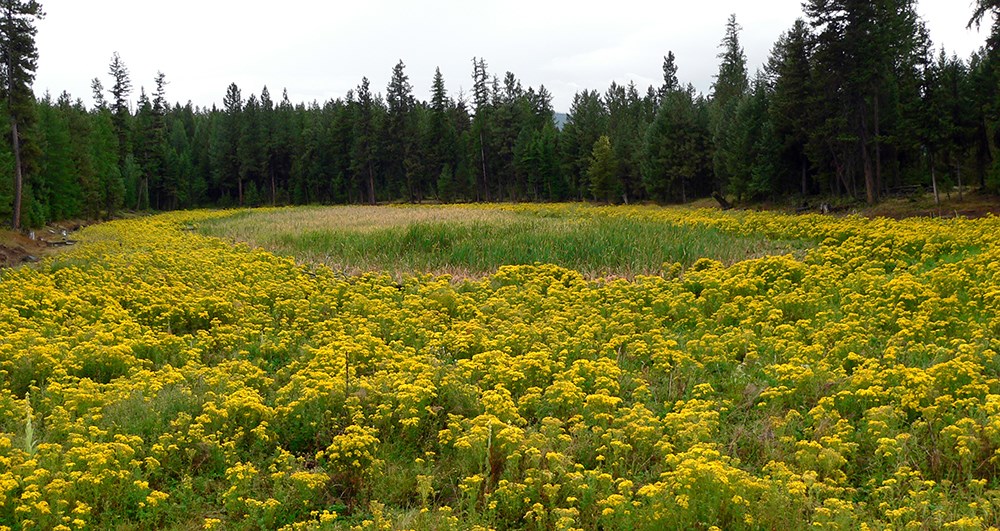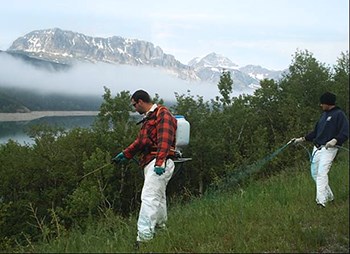Last updated: October 14, 2024
Article
Invasive Plants Resource Brief
Background Information

NPS
Threats
Once invasive plants inhabit an area, they can outcompete native plants for water and soil nutrients, as well as space to grow. In healthy plant communities, different types of root systems, from a variety of native plants, work together to hold the soil in place. An invasive, with its single type of root system, can increase soil erosion and in turn put local water resources at risk due to increased runoff. Such damage cannot be easily fixed, even if the weeds are successfully removed from the environment. Another consequence of invasive plants is a decrease in suitable wildlife habitat. When invasive plants become prevalent in an area, they severely reduce the availability of native plants that resident wildlife depend on for food sources. Wildlife may seek new areas to forage which can change the movement patterns of not only herbivores and ungulates, but their predators as well.
The term “weed” can be somewhat ambiguous. Basically, a weed is a plant out of place. Weeds that are not native to the area, destructive to the environment, and easily spread are termed noxious weeds. These invasive plants severely threaten native plant populations and the communities they support. Currently, there are 127 non-native species in Glacier National Park;18 of these are noxious weeds.
If weeds are plants out of place, how did they get to where they don’t belong? Some, like common tansy and oxeye daisy, were deliberately brought into the area by humans for cultivation. Plants then spread by seed and began growing elsewhere. Many species were never intentionally brought into Glacier National Park, but have spread from other areas, sometimes hundreds of miles away. Invasive plants are carried into new areas by people, animals, machinery, and wind.
Invasive plants are able to spread rapidly because they are so resilient. Outside of their natural environment, invasives are forced to compete with plants and animals they are not used to. Often they adapt into hardier strains of the original plant to cope with the stresses of their new environment, and even find new ways to reproduce. For example, spotted knapweed secretes a chemical into the ground that kills other species of plants that try to grow nearby. Areas of recent or constant disturbance, such as land impacted by fire or human activity from construction sites, roadsides, etc. are the most susceptible to weed invasion.
Status and Trends
Invasive plants have been present in Glacier National Park for many years. Trying to predict a population trend or determine a finite number of acres infested is difficult due to the dynamic nature of the plants and the environment. As of 2013, there are an estimated 9,527 acres within Glacier that are affected by invasive plants. Invasives are spreading at an alarming rate, and are invading the backcountry of Glacier National Park. These plants did not evolve here, so they have no natural predators to help control their population growth. Due to an increased effort of surveying for invasive plants in the past decade, four new invasive weeds have been discovered in the park. Each of these new populations was found when the infestations were small and, so far, continued spread has been contained and controlled. However, this is an issue that continues to grow and becomes more problematic the longer it is allowed to go on.
Education initiatives and research projects are ongoing to further the knowledge of invasive plants in Glacier. The Invasive Plant Citizen Science Project trains members of the public to detect and report the locations of targeted invasive plants in Glacier’s backcountry, assisting park managers with detecting new locations of these plants. Citizen scientists learn how to identify five species of noxious weeds that are already well-established in the park as well as three additional watch-list species that have been found in locations near Glacier’s borders. Having the additional eyes of citizen scientists on the park’s plant communities can help Glacier’s Invasive Plant Management Team become aware of and treat new infestations before they become established. Participants interested in getting involved with the park’s Invasive Plant Citizen Science Project can be trained either by completing an on-line training session or attending the annual Weed Blitz in late July.

NPS
Management Strategy
Due to the insidious nature of this threat, there are many approaches to managing the spread of invasive plants. Glacier National Park has chosen to use an Integrated Weed Management (IWM) approach to avoid harming Glacier’s native plant communities or interfering too extensively with the ecosystem. This multidisciplinary approach uses a variety of methods and treatments—manual, mechanical, cultural, biological, or chemical—that are best suited for specific species and locations.
Quickly managing any infestations that do arise saves time and money rather than attempting to remove immense populations of invasive plants. However, the most effective and easiest way to control an invasive weed problem is to avoid having one to begin with. By taking extra care to watch for weed seeds on clothing, shoes, boots, animals, and vehicles, anyone and everyone can help prevent the spread of invasive plants at the park, at home, or in their community.
Resources for More Information
Glacier National Park Staff
- Dawn LaFleur, Restoration/IPM Biologist
- Matt Kennedy, Supervisory Forestry Technician
Documents and web sites
- Invasive Plants of the Crown of the Continent Field Guide – www.crownmanagers.org/publications
- Center for Invasive Species Management: – www.weedcenter.org
- Montana Weed Control Association – www.mtweed.org
- Montana’s Noxious Weeds, Revised Edition (free download) – store.msuextension.org/Products/Montanas-NoxiousWeeds__EB0159.aspx
The Crown of the Continent Research Learning Center
Phone: 406-888-5827; Email: melissa_sladek@nps.gov
Website: www.nps.gov/rlc/crown
Downloadable pdf
Invasive Plants Resource Brief (221 KB)
